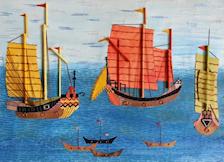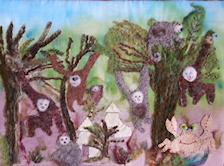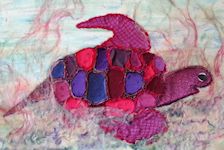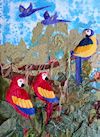Jean Wetton, the former group leader of Staffordshire Young Embroiderers, tells us of a wonderful project undertaken by her Young Embroiderers' Group, as part of Sea Britain.
Staffordshire Young Embroiderers were asked by Stafford Arts and Museum Services to make an embroidery depicting George Anson's journey around the world in search of treasure. He set sail in his ship, the Centurion, along with other ships. He stopped at many places and finally captured the Nuestra Senora de Covadonga, a Spanish treasure galleon on his way home. The reward he received from the King enabled him to build Shugborough Hall, near Stafford. As you can see, Jean has sent us some of the images of the great work done by the members of her group on the Shugborough project.
 |
 |
| Chinese Junks in Canton | Monkeys on the Brazilian Coast |
 |
 |
| Turtles on Island of Quibo, Gulf of Panama | Macaws on the Brazilian Coast |
Situated in a river valley in the heart of Staffordshire, Shugborough’s location is decidedly magical. It is little wonder that the Anson family should choose this idyllic setting to create the grandeur that is now this important estate.
In 1624, the land formed part of the estates of the Bishop of Lichfield. Eight acres of land together with a Manor House were purchased at the time by William Anson, a local lawyer, for the princely sum of £1000. But the story of Shugborough really begins 300 years ago in 1693 when William’s grandson, also called William demolished the manor house and built a three-storied house, which forms the centre of the house today. The transformation of that medium sized country house into a magnificent Georgian Mansion was carried out between 1745 and 1748 by the architect Thomas Wright, who added the pavilions either side of the 17th century block.
It was the two great grandsons of the first William Anson who were responsible for these important changes. Thomas, born in 1695, inherited the house, and it is his passion for the classical arts, influenced by his grand tour of Europe, that we see reflected in the house today, particularly in the rococo plasterwork of the dining room and library. But it was his daring and adventurous brother George, born in 1697, who provided the funding for these alterations.
Admiral George Anson
George Anson joined the navy at the age of 14, and through his exciting navy career brought fame, fortune and prestige to the Anson family name.n 1747 he was created Lord Anson and in 1751 was promoted to the first Lord of the Admiralty. We remember him best for his incredible voyage of circumnavigation of the globe between 1740 – 1744. He brought back with him a beautiful collection of Chinese wares, which is still displayed in the house today.
During that eventful voyage, Anson’s ship, the Centurion, after encountering many hardships and losing most of its crew, successfully fought and captured a Spanish treasure galleon. The treasure amounting to £400,000, was one of the largest prizes ever taken at sea by an English captain. Some of his fortune was used to develop Shugborough and acquire more land.
George Anson married Lady Elizabeth Yorke, daughter of the first Earl of Hardwick in 1748. They had no children and on his death his brother Thomas inherited the fortune. With this fortune Thomas was able to further his passion for classical architecture.
The embroidery was exhibited in Shugborough Hall in the room housing many artefacts from the journey.